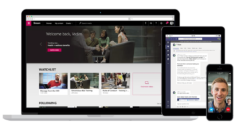Enterprise Video Broadcasts Increase Culture, Engagement and Productivity
CMMA BlogWhy has video broadcasting become one of the most vital tools for any large-scale enterprise? It comes down to three key benefits that can boost how a business connects with its own employees: Culture, Engagement and Productivity.
An astounding 50% of the global workforce will be Millennials by next year (2020), according to PWC – and they have a totally different approach to learning and entertainment from previous generations.
This is a maturing generation of highly educated people who watch YouTube videos to learn how to tie a bowtie or make the perfect craft cocktail. They binge-watch TV shows on Netflix or Amazon Prime. They catch up on the latest news or sports highlights with Twitter videos. Quite simply, it is more natural for them to watch a video than to read an email.
For large enterprises, this is creating an exciting new need to develop great video content, and to encourage their own staff to use the medium to become ambassadors for their own company.
Belgium’s largest bank, KBC Group, with more than 16,000 employees in Belgium and 42,000 worldwide, massively improved the quality of their internal communications using video. They have also taken it to the next level by encouraging staff to share their own videos including presentations and training materials.
Let’s look at the three key benefits of using video extensively across the enterprise, as they relate to KBC Bank.
Culture:
• Diversity & Inclusion – KBC wanted to harness the talents of all their people and help them feel included, well-trained and up to date on management decisions.
• Transparency – it was vital for the Board to be open and honest about the direction the company was headed.
• Trust – after the 2008 crash, trust in the banking sector was at an all-time low and KBC wanted to demonstrate how they do things differently: encouraging their employees to become ambassadors was a great way to do this.
Engagement:
• Alignment – KBC was able to provide unprecedented communications initiatives both internally and externally so that all employees understood the company direction.
• Purpose – this gave a new purpose to employees, with open, honest and engaging communication across the organisation, helping management and staff understand that their role at KBC is bigger than their job.
• Retention – the video programme helped to improve retention of talented and motivated staff. KBC’s video programme helped with engagement which is proven to help with retention.
Productivity:
• User Generated Value – KBC encourages staff to make their own quality content with easily-accessible portable video equipment, enabling every employee to become an ambassador. This has resulted in a huge upsurge in bottoms-up video with a 1500% increase in video production and distribution over five years.
• Training – both HR-driven and employee-led training is more accessible to all employees, thanks to video.
• Time to Market – KBC is moving quicker in its operations, while video distribution times have dropped from two hours to just two minutes. The KBC example is just one where Kollective has worked with a large enterprise to transform their communications philosophy and methods with hands-on support and technology.
The KBC example is just one where Kollective has worked with a large enterprise to transform their communications philosophy and methods with hands-on support and technology.
The post Enterprise Video Broadcasts Increase Culture, Engagement and Productivity appeared first on Kollective Technology .










